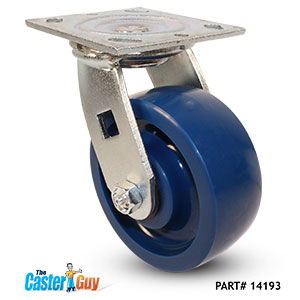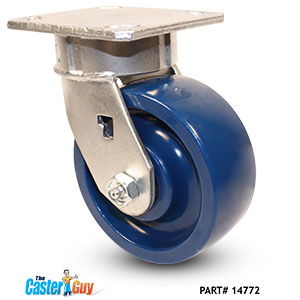When it comes to selecting the right caster for your application, understanding the difference between kingpin and kingpinless casters is crucial. At The Caster Guy, we aim to provide you with comprehensive insights to help you make an informed decision. In this guide, we will explore the key differences between these two types of casters, their advantages and disadvantages, and the best applications for each.
What are Kingpin Casters?

Kingpin Caster
Kingpin casters are a traditional type of caster that has been used for many years. They are characterized by a central kingpin that holds the caster together. The kingpin is a bolt or rivet that runs through the center of the caster, connecting the top plate, the bearing raceway, and the yoke, which holds the wheel. This design provides a sturdy and reliable connection between the components of the caster.
Advantages of Kingpin Casters
Kingpin casters offer several benefits, including:
- Strength: The kingpin provides a strong central connection, making these casters suitable for heavy-duty applications.
- Durability: Due to their robust design, kingpin casters can withstand significant wear and tear.
- Ease of Maintenance: The components of kingpin casters can be easily disassembled for maintenance and repairs.
Disadvantages of Kingpin Casters
Despite their advantages, kingpin casters have some drawbacks:
- Stress Concentration: The central kingpin can be a point of stress concentration, which may lead to failure under extreme loads or impacts.
- Potential for Loosening: Over time, the kingpin can become loose, reducing the caster’s effectiveness and stability.
- Weight: Kingpin casters are generally heavier due to the additional components required for the kingpin assembly.
What are Kingpinless Casters?

Kingpinless Caster
Kingpinless casters are a more recent innovation designed to address some of the limitations of traditional kingpin casters. As the name suggests, kingpinless casters do not have a central kingpin. Instead, they use a series of ball bearings to distribute the load more evenly across the bearing raceway. This design eliminates the single point of failure associated with kingpin casters and provides a more uniform load distribution.
Advantages of Kingpinless Casters
Kingpinless casters offer several advantages, including:
- Reduced Stress Concentration: By eliminating the kingpin, these casters distribute stress more evenly, reducing the risk of failure under heavy loads or impacts.
- Improved Durability: The absence of a central kingpin reduces the likelihood of component loosening, making these casters more durable over time.
- Smooth Operation: The ball bearing design allows for smoother and quieter operation, which is ideal for environments where noise reduction is important.
- Weight Savings: Kingpinless casters are often lighter than their kingpin counterparts, which can be beneficial in applications where weight is a concern.
Disadvantages of Kingpinless Casters
While kingpinless casters have many benefits, they also have some limitations:
- Complexity: The ball bearing design can be more complex and may require more precise manufacturing tolerances.
- Cost: Due to their advanced design, kingpinless casters can be more expensive than traditional kingpin casters.
- Maintenance: While they are generally durable, the ball bearings in kingpinless casters can wear out over time and may require periodic maintenance.
Applications for Kingpin and Kingpinless Casters
Choosing between kingpin and kingpinless casters depends on the specific requirements of your application:
Best Applications for Kingpin Casters
- Heavy-Duty Industrial Use: Kingpin casters are well-suited for applications that involve heavy loads and rough environments, such as industrial manufacturing and warehousing.
- High-Impact Areas: In areas where casters may experience significant impacts or shocks, the robust design of kingpin casters can be advantageous.
- Maintenance-Friendly Environments: If regular maintenance and repairs are feasible, kingpin casters offer the advantage of easy disassembly and reassembly.
Best Applications for Kingpinless Casters
- Noise-Sensitive Environments: The smooth and quiet operation of kingpinless casters makes them ideal for hospitals, offices, and other noise-sensitive areas.
- High-Load Applications: For applications that require a high load capacity without the risk of stress concentration, kingpinless casters are a great choice.
- Maintenance-Restricted Areas: In environments where maintenance is challenging, the durability of kingpinless casters can reduce the need for frequent repairs.
- Lightweight Applications: The weight savings offered by kingpinless casters can be beneficial in applications where reducing overall weight is important, such as in transportation equipment.
Conclusion
Understanding the differences between kingpin and kingpinless casters is essential for selecting the right caster for your specific needs. Kingpin casters offer strength and ease of maintenance, making them suitable for heavy-duty and high-impact applications. On the other hand, kingpinless casters provide improved durability, reduced stress concentration, and smoother operation, making them ideal for noise-sensitive, high-load, and maintenance-restricted environments.
At The Caster Guy, we offer a wide range of both kingpin and kingpinless casters to meet your requirements. Our experts are always available to help you choose the best caster for your application. Contact us today to learn more and find the perfect caster solution for your needs.

